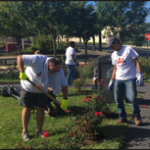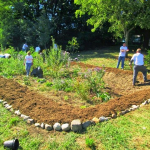New Jersey Future Blog
Street View: Fostering an Inclusive Community Through Complete and Green Streets
June 29th, 2022 by Aishwarya Devarajan
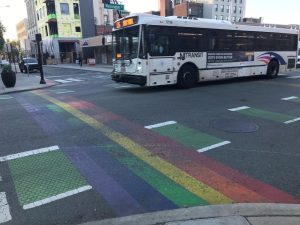
Colorful Crosswalks in Hoboken, New Jersey. Photo Credit: Andrew Tabas
From a satellite view, our streets, our towns, and our lives look picturesque. In reality, we know they are much messier than that. A quick glance at the street view and we see the reality of our towns in a muddy pair of childrens’ boots, hesitating to get on the school bus as a car closely zips behind them; in a little boy and his wheelchair-assisted grandma walking their dog on the gradually shortening shoulder of the road; in a man walking to his car with tires submerged in five inches of stormwater; in a woman looking up from her phone’s weather app which warns her of the poor local air quality as she reaches into her bag to grab her inhaler. As our streets get busier, filled with more stormwater and traffic pollution, and become increasingly inaccessible, implementing complete and green streets (CGS), as well as retrofitting green infrastructure, in our communities is imperative.
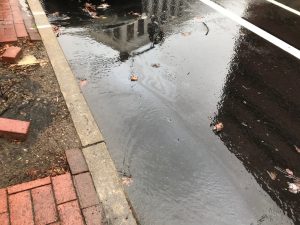
Polluted Stormwater Flooding on a Street in Trenton, New Jersey. Photo Credit: Andrew Tabas
CGS offer opportunities for urban and rural localities to manage stormwater, increase transportation options, support the local economy, and encourage active communities. Feasible implementation requires support from and collaboration between local, state, and federal governments.

Butterfly on a Joe Pye Weed in a Rain Garden. Photo Credit: Aishwarya Devarajan
At the Local Level:
Municipalities can pass ordinances and resolutions to support CGS in their area. These often formalize CGS efforts in a locality and commit to a longer investment. With appropriate planning and collaboration between departments, municipalities can save on much of the cost and work towards the same goal. For example, CGS elements, such as permeable roadways, can be added to a street at the time that the roadway needs to be dug up to access the pipes beneath it. Further, creating a long-term maintenance and funding plan will ensure the sustainability of these projects and reduce long-term repair costs. Retrofitting existing infrastructure with green infrastructure elements can also reduce costs while still maximizing benefits in multi-modal transportation and accessibility, stormwater management, traffic calming, community value and aesthetics.
Public support is essential for successful projects. An educational complete streets demo lab can help all ages of the community to engage with and visualize CGS in their town, and to learn more about the benefits of implementing CGS projects. According to the Collinswood Complete Streets Lab, these demonstrations use “low-cost materials like hay bales, straw, temporary paint and traffic cones, to test out infrastructure in a real-world setting, before investing in a permanent project” to capture local feedback.
At the State Level:
In their Model Complete and Green Streets Policy Guide, NJDOT recommends best practices for CGS and also references their own 2009 CGS policy requiring that “future NJDOT roadway improvement projects include safe accommodations for all users, including bicyclists, pedestrians, transit riders and the mobility-impaired.” This was a great start and NJDOT can do much more. Although NJDOT created this model policy, it is not a policy that NJDOT models.
The recently-enacted Safe Passing Law aims to protect all road users by requiring motorists to “maintain reasonable and safe distance when overtaking pedestrians and certain bicycles.” Further elements of CGS are encouraged and guided through NJDEP’s green infrastructure requirements.
Organizations at the state level that support CGS efforts include:
- Sustainable Jersey
- New Jersey Bicycle and Pedestrian Advisory Council
- Complete Streets Summit
- Jersey Water Works
- New Jersey Future’s Green Infrastructure Municipal Toolkit
At the Federal Level:
Similar to the state level, CGS are not mandated by the federal government. CGS street advocates can turn to the U.S. Department of Transportation’s Administration for safety guidelines, as well as the U.S. Environmental Protection Agency, for further resources.
Local funding efforts can be supported by grants at the state and federal level. Creativity is encouraged as towns can apply for non-CGS specific grants aimed at components that CGS tackle. For example, the U.S. Department of Transportation’s transportation alternatives set aside grant, administered by NJDOT, is aimed at environmental mitigation efforts to address stormwater management which aligns with CGS’ effective management of stormwater runoff and flooding.
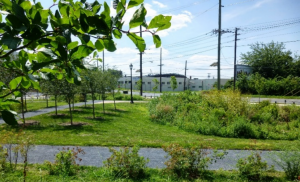
Bioretention area inside the Waterfront South rain gardens in Camden, New Jersey. Photo Credit: Jersey Water Works NJ Green Streets Case Studies
Bigger Picture on Smaller Scales
A functional, sustainable, and economical CGS requires that municipal departments work together, guided by clearly-defined stages and steps that can be found in the town’s CGS ordinance or the many resources available. Fostering inclusive communities through CGS is an achievable goal. By strategically collaborating, together we can create safer communities for all.
We would like to thank our interviewees in NJ, VA, and MI for their time and information.
Related Posts
Tags: CGS, complete and green streets, Complete Streets, green infrastructure, green streets, Stormwater



